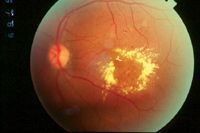Take an active role in patients' diabetes
As incidence of diabetes rises, optometrists will play greater role as part of patient's health care team.
As the incidence of diabetes continues to rise, optometrists can expect to play a greater role as part of the patient's health-care team.

Currently, an estimated 23.6 million people, or 7.8% of the U.S. population, have diabetes.1 Diabetes is the leading cause of new cases of blindness among adults between ages 20 and 74, with 12,000 to 24,000 new cases of blindness each year associated with diabetic retinopathy complications.1
Undiagnosed diabetes
What do you do, for example, if a patient presents with a fluctuation in refractive error or suspicious findings on a dilated fundus exam, and you suspect he or she has undiagnosed diabetes? This scenario could occur, given that 5.7 million patients with diabetes are undiagnosed.
"What do you do? Start with some questions during the case history: ask the patient if there is a family history of diabetes and if he or she has experienced such symptoms as neuropathies, increased appetite, excessive thirst, or frequent urination," Dr. Shechtman said.
Also, consider in-office or refer the patient for testing of fasting blood sugar (FBS) and glycosylated hemoglobin (HbA1c) levels. Regarding fasting blood sugar levels, look for levels above 126mg/dL; 110mg/dL to 125mg/dL constitutes prediabetes.). HbA1c levels above 6.5% can be used to diagnose diabetes.2

The ABCs of diabetes
"Although diabetic tests like HbA1C (A) are critical in the evaluation and monitoring of patients with diabetes, it is also important to evaluate other cardiovascular risk factors like high blood pressure (B) and hypercholesterolemia (C)," Dr. Shechtman said. "Various studies like the UK Prospective Diabetes Study (UKPDS), Hypertension in Diabetes Study (HDS), and Action to Control Cardiovascular Risk in Diabetes (ACCORD) determined that risk of complications of diabetes can be reduced dramatically by controlling patients HBP and hypercholesterolemia."4-7
Dr. Shechtman recommended measuring blood pressure (BP) in the office, especially considering that hypertension occurs in up to 68% of diabetic patients.8
"BP measurements re-emphasize our role as primary care physicians," she said.
The Early Treatment Diabetic Retinopathy Study (ETDRS) lays out a monitoring schedule for following patients with diabetic retinopathy. Patients should be followed about every 12 months with mild nonproliferative diabetic retinopathy (NPDR), every 6 months for moderate nonproliferative retinopathy and as often as every 2 months for more severe disease.9
Dr. Shechtman added, "Although the ETDRS' monitoring schedule is dictated by the stage of diabetic retinopathy, risk factors and associated abnormal findings may mandate more frequent follow-up. For example, patients with uncontrolled HTN may progress quicker.
"Although diabetic retinopathy is the leading cause of new cases of blindness, patients with diabetes also are at greater risk of other ocular complications. These include and are not limited to dry eye, cranial nerve palsies, optic neuropathies, retinal vascular occlusion, and earlier onset of cataracts," she said.
Dr. Shechtman refers patients who have clinically significant macular edema or proliferative diabetic retinopathy to a retinal specialist for further evaluation & treatment.
One caveat: "Remember that since diabetes mellitus is a multifactorial disease, we are co-managing with many other doctors, outside of ophthalmology," she said. "These may include nutritionist, internist, endocrinologist, cardiologist, dietician, and podiatrist. We are only one piece of the puzzle and thus, continuous communication with the patient's health care team is critical."